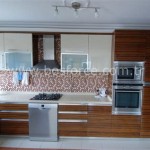```html
Kitchen Cabinet Setup: A Comprehensive Guide
Kitchen cabinets are fundamental to the functionality and aesthetics of a kitchen. Proper setup and organization are crucial for maximizing space, efficiency, and accessibility. This article provides a comprehensive guide to kitchen cabinet setup, covering key considerations from planning to execution.
Planning the Cabinet Layout
The initial stage of kitchen cabinet setup involves meticulous planning. This phase dictates the overall flow and usability of the kitchen. Several factors influence the planning process, including the kitchen's size and shape, the location of appliances, and the user's specific needs and preferences.
Begin by measuring the kitchen dimensions accurately. This measurement should include the wall length, height, and the location of windows, doors, plumbing fixtures, and electrical outlets. Create a detailed floor plan, either manually or using computer-aided design (CAD) software. The floor plan serves as a visual representation to experiment with different cabinet layouts.
Consider the work triangle concept, which emphasizes efficient movement between the sink, refrigerator, and stovetop. Optimizing the distance between these three key areas can significantly enhance workflow. Aim for a balanced layout that minimizes unnecessary steps and allows for smooth transitions during meal preparation.
Determine the types of cabinets required. Base cabinets, designed for floor placement, typically store heavier items and appliances. Wall cabinets, mounted on the wall, are ideal for storing dishes, glassware, and lighter pantry items. Tall cabinets, extending from floor to ceiling, offer maximum storage capacity and can accommodate larger items like brooms or cleaning supplies.
Explore different cabinet styles and finishes. Framed cabinets feature a face frame around the cabinet box opening, providing added stability and a more traditional look. Frameless cabinets, also known as European-style cabinets, have a sleek, contemporary appearance with full-overlay doors and exposed edges. The choice of cabinet style depends on the desired aesthetic and budget.
Consider incorporating specialized storage solutions within the cabinets. Pull-out shelves and drawers provide easy access to items stored deep inside cabinets. Lazy Susans maximize corner cabinet space. Vertical dividers organize baking sheets and cutting boards. These features enhance functionality and prevent clutter.
Budget allocation is a critical part of the planning process. Cabinet costs vary depending on the material, style, and features. Obtain quotes from multiple suppliers and compare prices. Factor in installation costs, which can add a significant expense to the project.
The Installation Process
The installation process requires precision and attention to detail. Improper installation can lead to alignment issues, structural instability, and reduced lifespan of the cabinets. While professional installation is recommended, experienced DIYers can tackle the project with proper preparation and tools.
Before starting the installation, ensure the walls are level and plumb. Correct any imperfections by shimming or patching as needed. Locate and mark the wall studs, as these provide the necessary support for wall cabinets. Use a stud finder to accurately identify the stud locations.
Begin by installing the base cabinets. Start with corner cabinets and work outward. Use shims to level each cabinet and secure them to the wall studs with screws. Ensure the cabinets are aligned and flush with each other. Connect the cabinets together to create a solid, cohesive unit.
Next, install the wall cabinets. Use a ledger board, a temporary support, to hold the cabinets in place while securing them to the wall studs. Ensure the cabinets are level and plumb before tightening the screws. Maintain consistent spacing between the wall and base cabinets.
Install the doors and drawers. Adjust the hinges and slides to ensure smooth operation and proper alignment. Check for any gaps or unevenness. Make any necessary adjustments to achieve a professional finish.
Install the countertops. Follow the manufacturer's instructions for installation and sealing. Ensure the countertops are level and properly supported. Apply sealant along the edges to prevent water damage.
Finally, install the hardware, such as knobs and pulls. Choose hardware that complements the cabinet style and finish. Use a template to ensure consistent placement of the hardware.
Organizing Cabinet Contents
Effective organization within kitchen cabinets maximises space and enhances accessibility. A well-organized kitchen promotes efficiency and reduces frustration during meal preparation. Implementing practical strategies can transform chaotic cabinets into orderly storage solutions.
Begin by decluttering the cabinets. Remove any items that are duplicates, expired, or no longer used. Donate or discard these items to free up valuable space. Group similar items together. This facilitates easy retrieval and prevents unnecessary clutter.
Employ vertical storage solutions. Stackable containers, tiered shelves, and drawer dividers maximize vertical space and prevent items from being buried at the back of cabinets. These solutions keep contents visible and easily accessible.
Utilize clear storage containers. These containers allow contents to be easily identified without the need to open each container. Label the containers for added clarity. Clear containers are particularly useful for storing pantry items, spices, and baking supplies.
Organize spices in a spice rack or drawer insert. This keeps spices organized and easily accessible. Alphabetize the spices for quick retrieval. Consider using small containers for storing bulk spices.
Designate specific zones within the cabinets. For example, create a baking zone, a cooking zone, and a cleaning zone. This helps to streamline meal preparation and cleaning processes. Keep frequently used items within easy reach.
Optimize under-sink storage. Use organizers to store cleaning supplies, sponges, and dish soap. Protect the cabinet floor with a liner to prevent damage from spills. Avoid storing harsh chemicals under the sink if children or pets are present.
Regularly maintain and reorganise the cabinets. This prevents clutter from accumulating and ensures that items remain organized. Conduct a thorough cleaning of the cabinets at least twice a year.
Consider the weight distribution within the cabinets. Store heavier items in lower cabinets to maintain stability and prevent tipping. Lighter items can be stored in upper cabinets. Arrange items to distribute weight evenly within each cabinet.
Implement a "first in, first out" system for perishable items. This ensures that older items are used before they expire. Rotate stock regularly to prevent food waste.
By following these guidelines, kitchen cabinet setup can be a streamlined process that results in a functional, aesthetically pleasing, and organized kitchen space.
```
House Planning How To Set Up Your Kitchen

Kitchen Cabinet Ideas The Home Depot

How We Organized Our Kitchen Drawers And Cabinets Jenna Sue Design

55 Best Kitchen Organization Ideas For Small Spaces

House Planning How To Set Up Your Kitchen

Kitchen Layout Organization Tips In 2024 How To Your

Where To Put Things In Kitchen Cabinets How Organize Your Downsize Declutter And Launch Professional Organizing Business

Diffe Types Of Kitchen Cabinet Doors For Your Home

Kitchen Layout Templates 6 Diffe Designs

Thinking Of Installing An Kitchen Here S What You Need To Know First
Related Posts








